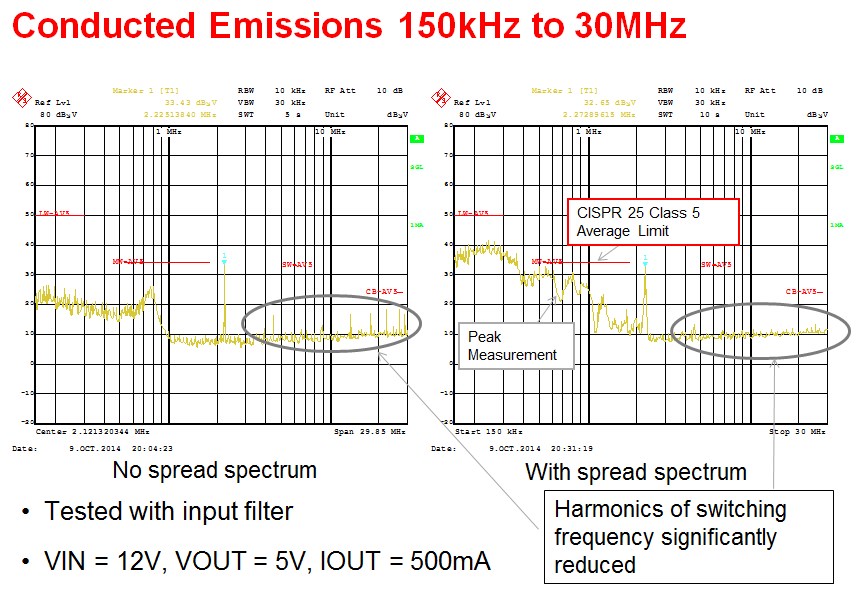SSZTCQ1 may 2015 LM26003 , LM26003-Q1 , LM26420 , LM26420-Q1
Spread spectrum is a technique associated with switching regulators that suppresses unwanted noise from bands of interest and pushes it into areas where the noise will not interfere with the system, or where it can be handled more easily.
Although the technique does not remove noise from the system – it is used only for avoiding critical bands – using spread spectrum is an industry trend at the moment, mainly driven by increasingly more complex systems and the need for a higher level of integration, leading to more interaction among systems across complex multilayer designs. The most obvious examples are the increase of the number of electronic control units (ECUs) in automobiles and the increasing complexity of the wire harness. The wire harness needs to carry signal, power and communications at increasingly higher levels.
The modern power-supply engineer is finding newer specifications come across his desk, where the suppression of noise in specific bands is becoming tougher, and targets are going lower and lower to cater to the increase in system complexity. Many see the spread-spectrum technique as an answer, as it can remove peak noise and make power-supply designs meet the target noise specification.
Spread spectrum is by no means a simple answer in its implementation; you also must consider several modulation techniques. Within the technique are methods like pseudo random, triangular and sawtooth, as well as jitter percentage of the fundamental frequency and the deviation or repetition rate of the jitter. All of these knobs have some kind of additional and possibly unwanted effect on noise.
Figure 1 shows the use of spread-spectrum technique to suppress noise and the automotive standard CISPR 25, Class 5 is added as a basis for comparison. What Figure 1 shows is the suppression of the noise in the harmonic band of the fundamental (in this case, 2.1 MHz). You can clearly see that noise is suppressed, above the fundamental frequency. Suppressing noise at higher frequencies leads to an easier power-supply design and a greater ability to meet the noise targets.
However, if you look at the subharmonics, you can see that the noise has grown, and while it still meets the specification of the CISPR 25 standard, it can cause issues in the AM band. The digital signal processor (DSP) has to be used to remove this unwanted noise in the AM band – or, even worse, it’s still audible. This AM Interference is very unattractive in systems like infotainment and can mean a more complex input digital filter. So rather than removing the problem, it just pushes it to another part of the design, and from the analog design engineer to the digital design engineer.
 Figure 1 Conducted Band CISPR 25, Class
5 with and without Spread Spectrum
Figure 1 Conducted Band CISPR 25, Class
5 with and without Spread SpectrumSo what can you do? The simple answer is to stop the noise in the first place. By using integrated circuit (IC) technology tuned for noise suppression and good printed circuit board (PCB) layout techniques, it is possible to limit the problem. If you don’t generate the noise or if you can limit it, then you don’t need to suppress it; or perhaps you can suppress it at a less-aggressive level so other techniques are more beneficial. Only use spread spectrum with caution, and in situations where the benefits are known and don’t affect other circuits and designs.
A good example of how to layout power supplies for low noise would be TI's PMP9458 reference design. The “CISPR 25 Class 5 Rated 14W Multi-Output Power Supply for Automotive Cluster Unit” reference design” deliberately uses both sub-AM band (lower than 1 MHz) and high frequency (higher than 2 MHz) switching regulators on the same printed circuit board. It also uses a combination of ASYNC and SYNC products, which have been designed at the IC level to suppress noise. Remember to use good layout techniques to suppress noise from the outset.
Used in systems where it can benefit the design engineer’s system performance, I would argue that the spread-spectrum technique is both a headache tablet and a vitamin pill, depending on when it is used. Good PCB design and component selection will have as much affect on your design outcome, benefiting the sytem solution as a whole and perhaps not pushing the problem into a different domain. I would carefully consider the benefits of such techniques before implementation.
 Figure 2 PMP9458 Reference Design for the LM26003-q1 And LM26420-q1
Figure 2 PMP9458 Reference Design for the LM26003-q1 And LM26420-q1Additional Resources :
- Download the "PMP9458 CISPR 25 Class 5 Rated 14W Multi-Output Power Supply for Automotive Cluster Unit" reference design.
- Consider TI’s LM26003-q1 3A switching regulator with high efficiency sleep mode and LM26420-q1 dual 2.0A, high frequency synchronous step-down DC/DC regulator for your next design.